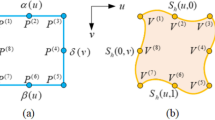Abstract
Surface triangle meshes and volume data are two commonly used representations of digital geometry. Converting from triangle meshes to volume data is challenging, since triangle meshes often contain defects such as small holes, internal structures, or self-intersections. In the extreme case, we may be simply presented with a set of arbitrarily connected triangles, a “triangle soup”. This paper presents a novel method to generate volume data represented as an octree from a general 3D triangle soup. Our motivation is the Faraday cage from electrostatics. We consider the input triangles as forming an approximately closed Faraday cage, and set its potential to zero. We then introduce a second conductor surrounding it, and give it a higher constant potential. Due to the electrostatic shielding effect, the resulting electric field approximately lies in that part of space outside the shape implicitly determined by the triangle soup. Unlike previous approaches, our method is insensitive to small holes and internal structures, and is observed to generate volumes with low topological complexity. While our approach is somewhat limited in accuracy by the requirement of filling holes, it is still useful, for example, as a preprocessing step for applications such as mesh repair and skeleton extraction.
Similar content being viewed by others
References
Lorensen W E, Cline H E. Marching cubes: A high resolution 3D surface construction algorithm. In Proc. SIGGRAPH1987, Anaheim, USA, July 27-31, 1987, pp.163-169.
Ju T, Losasso F, Schaefer S, Warren J. Dual contouring of hermite data. In Proc. SIGGRAPH 2002, San Antonio, USA, July 21-36, 2002, pp.339-346.
Huang J, Yagel R, Filippov V, Kurzion Y. An accurate method for voxelizing polygon meshes. In Proc. 1998 IEEE Symposium on Volume Visualization, Research Triangle Park, USA, Oct. 24, 1998, pp.119-126.
Oomes S, Snoeren P, Dijkstra T. 3D shape representation: Transforming polygons into voxels. In Proc. SCALE SPACE1997, Utrecht, The Netherlands, July 2-4, 1997, pp.349-352.
Frisken S F, Perry R N, Rockwood A P, Jones T R. Adaptively sampled distance fields: A general representation of shape for computer graphics. In Proc. SIGGRAPH 2000, New Orleans, USA, July 23-28, 2000, pp.249-254.
Ju T. Fixing geometric errors on polygonal models: A survey. J. Comput. Sci. Technol., 2009, 24(1): 19-29.
Ju T. Robust repair of polygonal models. ACM Trans. Graph., 2004, 23(3): 888-895.
Ju T, Baker M L, Chiu W. Computing a family of skeletons of volumetric models for shape description. Computer-Aided Design, 2007, 39(5): 352-360.
Nooruddin F S, Turk G. Simpli¯cation and repair of polygonal models using volumetric techniques. IEEE Transactions on Visualization and Computer Graphics, 2003, 9(2): 191-205.
Nooruddin F S, Turk G. Interior/exterior classification of polygonal models. In Proc. VIS 2000, Salt Lake City, USA, Oct. 8-13, 2000, pp.415-422.
Zhang E, Turk G. Visibility-guided simplification. In Proc. VIS 2002, Boston, USA, Oct. 27-Nov. 1, 2002, pp.267-274.
Dachille F, Kaufman A E. Incremental triangle voxelization. In Proc. Graphics Interface 2000, Montreal, Canada, May 15-17, 2000, pp.205-212.
Andújar C, Brunet P, Ayala D. Topology-reducing surface simplification using a discrete solid representation. ACM Trans. Graph., 2002, 21(2): 88-105.
Sigg C, Peikert R, Gross M. Signed distance transform using graphics hardware. In Proc. VIS 2003, Seattle, USA, October 19-24, 2003, pp.83-90.
Carr J C, Beatson R K, Cherrie J B, Mitchell T J, FrightWR, McCallum B C, Evans T R. Reconstruction and representation of 3D objects with radial basis functions. In Proc. SIGGRAPH2001, Los Angeles, USA, Aug. 12-17, 2001, pp.67-76.
Kazhdan M, Bolitho M, Hoppe H. Poisson surface reconstruction. In Proc. SGP 2006, Cagliari, Italy, June 26-28, 2006, pp.61-70.
Shen C, O'Brien J F, Shewchuk J R. Interpolating and approximating implicit surfaces from polygon soup. In Proc. SIGGRAPH 2004, Los Angeles, USA, Aug. 8-12, 2004, pp.896-904.
Griffiths D J, Inglefield C. Introduction to Electrodynamics. Prentice Hall, 1999.
Li X, Guo X, Wang H, He Y, Gu X, Qin H. Harmonic volumetric mapping for solid modeling applications. In Proc. SPM2007, Beijing, China, June 4-6, 2007, pp.109-120.
Kreyszig E. Advanced Engineering Mathematics. John Wiley, 2005.
Rosell J, Iniguez P. A hierarchical and dynamic method to compute harmonic functions for constrained motion planning. In Proc. IROS 2002, Lausanne, Switzerland, Sept. 30-Oct. 4, 2002, pp.2335-2340.
Grady L. Random walks for image segmentation. IEEE Trans. Pattern Anal. Mach. Intell., 2006, 28(11): 1768-1783.
Zhou Q Y, Ju T, Hu S M. Topology repair of solid models using skeletons. IEEE Transactions on Visualization and Computer Graphics, 2007, 13(4): 675-685.
Author information
Authors and Affiliations
Corresponding author
Additional information
This work was supported by the National Basic Research 973 Program of China under Grant No. 2006CB303106, the National Natural Science Foundation of China under Grant Nos. 90718035 and U0735001.
Rights and permissions
About this article
Cite this article
Shen, CH., Zhang, GX., Lai, YK. et al. Harmonic Field Based Volume Model Construction from Triangle Soup. J. Comput. Sci. Technol. 25, 562–571 (2010). https://doi.org/10.1007/s11390-010-9345-x
Received:
Revised:
Published:
Issue Date:
DOI: https://doi.org/10.1007/s11390-010-9345-x




